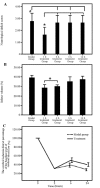Protective effect of tanshinone IIA on the brain and its therapeutic time window in rat models of cerebral ischemia-reperfusion
- PMID: 25289069
- PMCID: PMC4186358
- DOI: 10.3892/etm.2014.1936
Protective effect of tanshinone IIA on the brain and its therapeutic time window in rat models of cerebral ischemia-reperfusion
Abstract
The aims of the present study were to investigate the protective effect of tanshinone IIA on the brain and its therapeutic time window in a rat model of cerebral ischemia-reperfusion. The rat model of cerebral ischemia-reperfusion was established by suture occlusion. In an initial experiment, male Sprague-Dawley (SD) rats were randomly divided into control cerebral ischemia-reperfusion rat model, tanshinone IIA1 (TSA1), tanshinone IIA4 (TSA4), tanshinone IIA6 (TSA6) and tanshinone IIA12 (TSA12) groups (n=8 per group). The rats in the control group were given 4 ml phosphate-buffered saline (PBS) intraperitoneally following suture occlusion. The other groups were respectively treated with 25 mg/kg tanshinone IIA intraperitoneally at 1, 4, 6 and 12 h following the initiation of reperfusion and once a day for a total of three days. The grades of neurologic impairment and volume of cerebral infarction of each group were measured 72 h after suture occlusion. In another experiment, 16 male SD rats were randomly divided into a 6 h reperfusion group and a 24 h reperfusion group following drug administration. The rats in each group were further divided into a control subgroup (4 ml PBS) and a tanshinone IIA subgroup (25 mg/kg). The rats were immediately administered their respective treatments following the establishment of the model. The rats were decapitated 6 and 24 h after the initiation of reperfusion. The expression levels of cytoplasmic thioredoxin (Trx-1) and mitochondrial thioredoxin (Trx-2) in the ischemic penumbra were determined by western blot analysis. The nitric oxide (NO) levels, and total NO synthase (tNOS) and inducible NO synthase (iNOS) activities in the rat blood were measured using a reagent kit. The changes in cerebral blood flow were evaluated by Doppler imaging. The grade of neurological impairment of the TSA1 group was statistically lower than that of the other groups (P<0.05). The cerebral infarction volume results showed that the volumes of infarction in the TSA1 and TSA4 groups were lower than those in the other groups (P<0.05). Tanshinone IIA significantly increased cerebral blood flow compared with that of the control group (P<0.05). Moreover, tanshinone IIA significantly increased the expression levels of Trx-1 and Trx-2 compared with those in the control group (P<0.05). Tanshinone IIA significantly decreased the NO levels and iNOS and tNOS activities compared with those of the control group (P<0.05). However, the iNOS activity in the rats in the 6 h reperfusion group was not statistically significantly different from that of the respective control group (P>0.05). Tanshinone IIA has a protective effect on the cranial nerves when administered during the initial stages of cerebral ischemia. This protective effect is associated with an improvement of cerebral blood flow as well as an increase in anti-oxygen radical and anti-inflammatory activities.
Keywords: middle cerebral artery occlusion; neuroprotection; tanshinone; time window.
Figures


Similar articles
-
Tanshinone IIA Against Cerebral Ischemic Stroke and Ischemia- Reperfusion Injury: A Review of the Current Documents.Mini Rev Med Chem. 2024;24(18):1701-1709. doi: 10.2174/0113895575299721240227070032. Mini Rev Med Chem. 2024. PMID: 38482618 Review.
-
Protective effect of Sheng-Nao-Kang decoction on focal cerebral ischemia-reperfusion injury in rats.J Ethnopharmacol. 2014;151(1):228-36. doi: 10.1016/j.jep.2013.10.015. Epub 2013 Oct 22. J Ethnopharmacol. 2014. PMID: 24161430
-
Studies on the active constituents in radix salviae miltiorrhizae and their protective effects on cerebral ischemia reperfusion injury and its mechanism.Pharmacogn Mag. 2015 Jan-Mar;11(41):69-73. doi: 10.4103/0973-1296.149706. Pharmacogn Mag. 2015. PMID: 25709213 Free PMC article.
-
Efficacy of tanshinone IIA in rat models with myocardial ischemia-reperfusion injury: a systematic mini-review and meta-analysis.PeerJ. 2024 Aug 16;12:e17885. doi: 10.7717/peerj.17885. eCollection 2024. PeerJ. 2024. PMID: 39161965 Free PMC article.
-
Effects and Mechanism of Action of Inducible Nitric Oxide Synthase on Apoptosis in a Rat Model of Cerebral Ischemia-Reperfusion Injury.Anat Rec (Hoboken). 2016 Feb;299(2):246-55. doi: 10.1002/ar.23295. Epub 2015 Dec 29. Anat Rec (Hoboken). 2016. PMID: 26598930
Cited by
-
Neuroprotective investigation of tanshinone in the cerebral infarction model in the Keap1-Nrf2/ARE pathway.Cell Cycle. 2023 Feb;22(4):390-402. doi: 10.1080/15384101.2022.2119687. Epub 2022 Sep 6. Cell Cycle. 2023. PMID: 36066030 Free PMC article.
-
Effects of albendazole combined with TSII-A (a Chinese herb compound) on optic neuritis caused by Angiostrongylus cantonensis in BALB/c mice.Parasit Vectors. 2015 Nov 25;8:606. doi: 10.1186/s13071-015-1214-6. Parasit Vectors. 2015. PMID: 26608105 Free PMC article.
-
Tanshinone IIA attenuates demyelination and promotes remyelination in A. cantonensis-infected BALB/c mice.Int J Biol Sci. 2019 Aug 19;15(10):2211-2223. doi: 10.7150/ijbs.35266. eCollection 2019. Int J Biol Sci. 2019. PMID: 31592236 Free PMC article.
-
Tanshinone IIA Against Cerebral Ischemic Stroke and Ischemia- Reperfusion Injury: A Review of the Current Documents.Mini Rev Med Chem. 2024;24(18):1701-1709. doi: 10.2174/0113895575299721240227070032. Mini Rev Med Chem. 2024. PMID: 38482618 Review.
-
Intracisternal administration of tanshinone IIA-loaded nanoparticles leads to reduced tissue injury and functional deficits in a porcine model of ischemic stroke.IBRO Neurosci Rep. 2021 Jan 5;10:18-30. doi: 10.1016/j.ibneur.2020.11.003. eCollection 2021 Jun. IBRO Neurosci Rep. 2021. PMID: 33842909 Free PMC article.
References
-
- Chollet F, Cramer SC, Stinear C, et al. Pharmacological therapies in post stroke recovery: recommendations for future clinical trials. J Neurol. 2013 (Epub ahead of print) - PubMed
-
- Candelario-Jalil E. Injury and repair mechanisms in ischemic stroke: considerations for the development of novel neurotherapeutics. Curr Opin Investig Drugs. 2009;10:644–654. - PubMed
-
- Lo EH, Dalkara T, Moskowitz MA. Mechanisms, challenges and opportunities in stroke. Nat Rev Neurosci. 2003;4:399–415. - PubMed
LinkOut - more resources
Full Text Sources
Other Literature Sources
Research Materials
